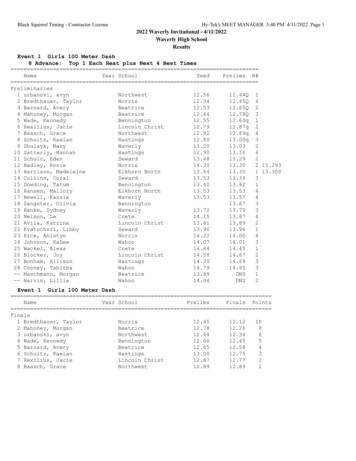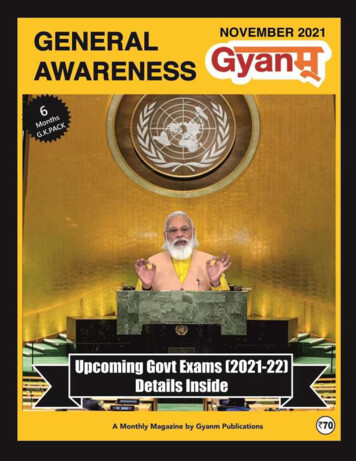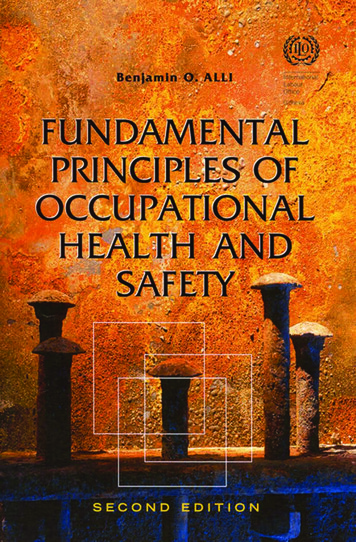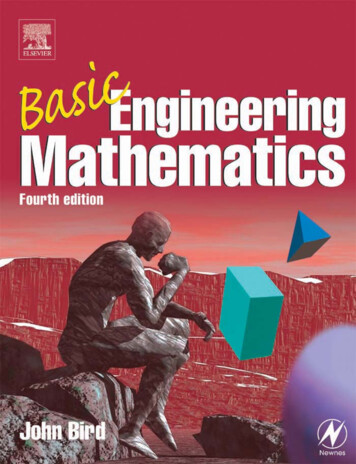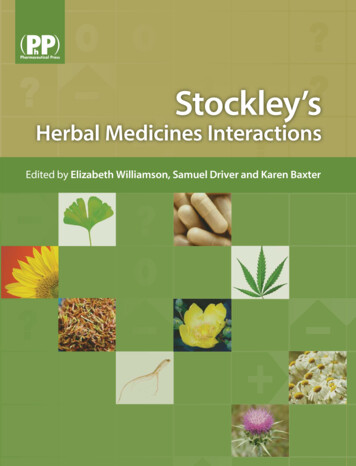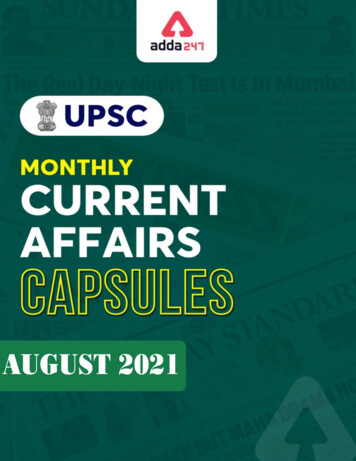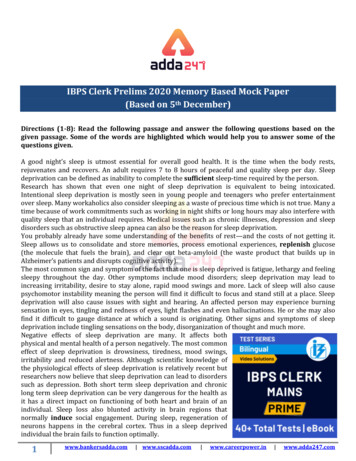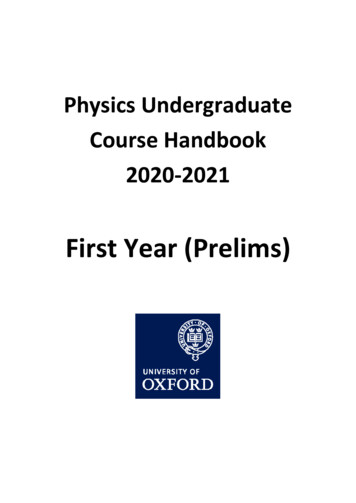
Transcription
Physics UndergraduateCourse Handbook2020-2021First Year (Prelims)
Map of the Department of Physics BuildingsUseful Department ContactsHead of TeachingProf H Kraushans.kraus@physics.ox.ac.ukAssistant Head of TeachingMrs C cs.ox.ac.ukDisability ContactMrs C .ac.uk72407Teaching Laboratory ManagerDr Jenny Barnesjenny.barnes@physics.ox.ac.uk73491Teaching Office AdministrationMiss H c.ukTeaching Office e-mail addressteachingadmin@physics.ox.ac.ukTeaching lab supportlabhelp@physics.ox.ac.ukPJCC Websitehttps://pjcc.physics.ox.ac.uk/These notes have been produced by the Department of Physics. The information in this handbook isfor the academic year Michaelmas Term 2020, Hilary Term 2021 and Trinity Term 2021.2
ContentsMap of the Department of Physics Buildings . 2Useful Department Contacts . 2Coronavirus (Covid) . 6Introduction to the handbook . 6Other useful sources of information: . 6Introduction to the Department of Physics . 8The Department of Physics . 8The Physics Teaching Office . 8Teaching Laboratories . 8Lecture Theatres . 8Communications. 8Computers . 9Social spaces and facilities. 9Policies and Regulations . 9Data Protection . 9University Policy on Intellectual Property Rights . 9Copyright . 9Good academic practice and avoiding plagiarism . 10Support for disabled students . 10Student Life, Support and Guidance . 10Complaints and appeals . 10Opportunities for skills training and development . 11Employability and careers information and advice . 11Departmental representation - The Physics Joint Consultative Committee (PJCC) . 11Opportunities to provide evaluation and feedback . 11Mathematical, Physical and Life Sciences (MPLS) Division and University Representation . 11Enterprise and entrepreneurship . 12The Institute of Physics. 12The Physics Undergraduate Courses . 13Aims and Objectives . 13Subject Benchmark Statements . 14Department and College Teaching . 14Expectations of study and student workload (Term time and Vacations) . 14Aims of Practical Work . 15Programme Specifications . 16Accreditation . 16Accessing the Physics Teaching web pages . 163
Virtual Private Network (VPN) Service . 16First Year 2020-2021 . 17Induction . 17Safety Lecture . 17Practical Work commencement . 17Self-study modules in basic mathematics and physics . 17Introduction to Computer Programming . 18Data Analysis and Statistics . 18Textbooks . 18First Year Physics and Maths Lectures . 18Short Options . 18Academic Progress . 18Physics and Philosophy . 19First Year Patterns of Teaching . 20Timetable . 20Course structure . 20Practical Work . 21Organisation . 21Assessment . 22Marking . 23Physics Examinations . 24Examination Entry . 24Examination Dates . 24Examination Regulations . 24Examination Conventions . 24Examination Preparation . 25Past Exam papers . 25Examiners’ Reports . 25Sitting your examination . 25Prelims Examination . 26Assessment of Practical Work . 26Examination Results . 26Year Outcomes for Prelims . 27Resits . 27Examination in further years . 28Appendix ARecommended Textbooks . 29First Year . 29Short Options . 314
Appendix BNote on Calculators for ALL Public Examinations* . 32Appendix CSyllabuses for the First Year (Preliminary Examination in Physics) . 33Introduction . 33CP1. Physics 1 . 33CP2. Physics 2 . 34CP3. Mathematical Methods 1 . 35CP4. Mathematical Methods 2 . 36Data Analysis and Statistics . 37S01. Functions of a complex variable . 37S02. Astrophysics: from planets to the cosmos . 38S03. Quantum Ideas . 38Appendix DMark scheme for practicals . 39Appendix ESummary of Prelims experiments . 41Appendix FComplaints and Appeals . 465
Coronavirus (Covid)The University publishes updates at https://www.ox.ac.uk/coronavirus. Adaptations to the physicsundergraduate course, made necessary due to Coronavirus (Covid) derive from the university guidelinesand are laid out within the lectures and practical course arrangements.Introduction to the handbookA handbook is provided for each year of the programme and it is also useful to read the handbooks ontopics available in later years. This handbook contains, amongst other things, a comprehensivebook/reading list, also available via ORLO (Oxford Reading List Online); important dates for the academicyear; information about the undergraduate consultative committee (PJCC); and a list of people involvedin organising the course. Please read this handbook thoroughly and refer to it frequently, as it will oftencontain the answers to many common questions.Other useful sources of information:Full details about the Practical work can be found in this handbook and on Canvas.Please refer to the Physics and Philosophy Course Handbook ates for all details of the Physics and Philosophycourse that are not covered in the Physics Undergraduate Course Handbook.For particular information about college teaching, students should contact their tutors. Furtherinformation about the courses can be obtained from the Department of Physics graduates and from the Physics Teaching Office.In this document, Michaelmas Term (MT), Hilary Term (HT), Trinity Term (TT), refer to Michaelmas,Hilary and Trinity Terms of the academic year, respectively. The weeks in each term are numbered as1st week, 2nd week and so on, with 0th week being the week immediately before the start of full term.For full and up-to-date information on follow this link to the lecture timetables.The examination times given in this handbook are based on information available in September 2020.These may change and the definitive times are those published by the examiners on the officialexaminers’ page.The Examination Regulations relating to this course are available at https://examregs.admin.ox.ac.uk/.If there is a conflict between information in this handbook and the Examination Regulations then youshould follow the Examination Regulations. If you have any concerns please contact the AssistantHead of Teaching by e-mail at carrie.leonard-mcintyre@physics.ox.ac.uk.The information in this handbook is accurate as at 5 October 2020, however it may be necessary forchanges to be made in certain circumstances, as explained ates. If such changes are made, the Departmentwill publish a new version of this handbook together with a list of the changes and students will beinformed.6
Important dates and deadlinesMichaelmas TermEventTimeLocationWeek 0Introduction to theDepartment (Induction)Fri14:15Online onlyWeek 1Laboratory IntroductionMon12:00Online onlyWeek 1Safety LectureMon14:00Online onlyWeek 4Deadline for CO01 (computing)Fri 17:00Teaching LaboratoriesWeek 8Deadline for CO02 (computing)Fri 17:00Teaching LaboratoriesTimeLocationHilary TermEventWeek 4Entry for PrelimsFri*Week 7Deadline for CO6x (computing)Fri 17:00Teaching LaboratoriesTimeLocationWeek 1Last day to do practicals and get Fri 10:00any outstanding work assessedTeaching LaboratoriesWeek 2Deadline for markingPractical workFri noonTeaching LaboratoriesWeek 3Entry for Short Option choicesFri*Week 7Prelims examinationTrinity TermEvent*** Students submit their entries via their College Office and Student Self Service.** See ables for the exam timetables.*** See http://www.physics.ox.ac.uk/lectures/ for lecture details.7
Introduction to the Department of PhysicsThe Department of PhysicsThe Department of Physics at the University of Oxford is one of the largest in the UK, with an averageannual intake of just under 200 undergraduates, of whom approximately 180 study for an MPhys or aBA in Physics and approximately 15-20 for an MPhysPhil in Physics and Philosophy. The academic staffare based in six sub-departments: Astrophysics; Atmospheric, Oceanic and Planetary Physics; Atomicand Laser Physics; Condensed Matter Physics (including BioPhysics); Particle Physics and TheoreticalPhysics. These represent the main areas of research carried out in the Department.The Department is located in four buildings shown on the map on page 2: the Denys Wilkinson Building(DWB) on the west side of Parks Road; the Beecroft Building, Clarendon Laboratory and theAtmospheric, Oceanic and Planetary Physics Building on the east side of Parks Road. You will need touse your University card to gain access to all physics buildings. The Beecroft Building is a solely researchbuilding, and therefore not available for use by undergraduates.The Physics Teaching OfficeAll undergraduate teaching is arranged and organised in the Department by the Physics Teaching Office.Tutorials are arranged by college tutors. The Physics Teaching Office is located in the ClarendonLaboratory.Teaching LaboratoriesAll the undergraduate teaching laboratories are located on the lower two floors of the DWB, togetherwith a reception area where undergraduates can meet and obtain refreshments; the entrance is fromKeble Road down a flight of steps.Lecture TheatresThere are lecture rooms in all buildings, the main ones being the Martin Wood and Lindemann LectureTheatres in the Clarendon Laboratory and the Dennis Sciama Lecture Theatre in the DWB. The currententrance to the Clarendon laboratory is from the Martin Wood Building where you will find the MartinWood Lecture Theatre. The Lindemann Lecture Theatre is on the first floor. To enter the DWB, go upthe wide concrete steps from Keble Road; turn left at the top and the entrance is facing you. Once inside,the lecture theatre is one floor up from the entrance.CommunicationsAcademic staff have pigeon holes in the building where they have an office and there is a messengerservice that can be used to deliver mail between colleges and departments. Staff may also be contactedby telephone or by e-mail.All administrative information about the course and the examinations is sent to students by e-mail. Itis essential that students using e-mail accounts, other than their college account,joe.bloggs@college.ox.ac.uk, set the forwarding appropriately and check their e-mail regularly, at leastonce a day during term. Some important information from the Physics Teaching Office and Universityis sent to individual students by the messenger service, or is distributed via College Senior PhysicsTutors. Notices about the examinations are posted on the official examiners’ page.8
ComputersIn a normal year, there are numerous computer workstations in the teaching laboratories on Level 2 ofthe DWB and normally students can use the computers at any time during office hours including duringvacations. However, in the current global situation, this facility is closed for the academic year 2020-21.We recommend that all students obtain use of a computer, either their own personal laptop or use ofa college computer. The colleges all have computing facilities for their undergraduates and there is aUniversity-wide network, which enables students to access Departmental sites and the internet.Undergraduates will also receive an account and a College e-mail address on the University computingsystem. All new users will be asked to abide by the University Rules on the use of computers (seehttps://www.ox.ac.uk/students/life ). Students should check their e-mails regularly, at least once a dayduring term.Social spaces and facilitiesNormally, students are allowed to use the Common Rooms in the Clarendon Laboratory and the DWBfor meals and refreshments. There are vending machines in the reception area of the teachinglaboratories in the DWB and in the corridor on the first floor of the Clarendon Laboratory between theLindemann and the Martin Wood Lecture Theatres. You may not take any food or drink into the lecturetheatres, the teaching laboratories or near any departmental computers.LibrariesCollege libraries are generally well stocked with the recommended physics textbooks, but if your libraryis without a book you need you should tell your tutor or your College librarian. A list of the booksrecommended by the lecturers is given in Appendix A and is also available via ORLO (Oxford ReadingList Online).Policies and RegulationsThe University has a wide range of policies and regulations that apply to students. These are easilyaccessible through the A-Z of University regulations, codes of conduct and policies available on theOxford Students website www.ox.ac.uk/students/academic/regulations/a-z. In particular, see thePolicy on recording lectures by students (located ce)Data ProtectionThe Physics Department follows the general guidelines laid down by the University in regard to theprovisions of the Data Protection Act 1998 (see http://www.admin.ox.ac.uk/dataprotection/ fordetails.) Only student information relevant to the organisation of the physics courses is held by theDepartment.University Policy on Intellectual Property RightsThe University of Oxford has arrangements in place governing the ownership and exploitation ofintellectual property generated by students and researchers in the course of, or incidental to, theirstudies. More details are available at ip/policyCopyrightGuidance about copyright is published at ht. TheUniversity holds a licence from the Copyright Licensing Agency (CLA) which permits multiple copying9
(paper to paper) from most copyright-protected books, journals, law reports, conference proceedingsand magazines for use by students and the course tutor on registered taught courses and non-creditbearing short courses.Good academic practice and avoiding plagiarism“Plagiarism is presenting someone else’s work or ideas as your own, with or without their consent, byincorporating it into your work without full acknowledgement. All published and unpublished material,whether in manuscript, printed or electronic form, is covered under this definition.Plagiarism may be intentional or reckless, or unintentional. Under the regulations for examinations,intentional or reckless plagiarism is a disciplinary offence” plagiarism.The Teaching Office uses “Turnitin” as a tool that allows papers (projects) to be submitted electronicallyto find whether parts of a document match material which has been previously submitted. All worksubmitted will be checked with Turnitin. Copying sources (e.g. Wikipedia) word for word will not beaccepted, unless speech marks are used around a very short extract from the source and the source iscorrectly referenced.See generic/avoidplag for an online course onavoiding plagiarism.Support for disabled students“Disability is a much broader term than many people realise. It includes all students who experiencesensory and mobility impairments, mental health conditions, long-standing health conditions, socialcommunication conditions or specific learning difficulties where the impact on day-to-day life issubstantial and long term.” [ref: Student Handbook 17-18.] The Department is able to make provisionfor these students. Contact the Assistant Head of Teaching, the Disability Contact for the Department,about your requirements. See http://www.admin.ox.ac.uk/eop/disab/ for more information. TheExamination Regulations provide guidance for students with special examination needs, seehttp://www.admin.ox.ac.uk/examregs/ for more information.Student Life, Support and GuidanceEvery College has their own system of support for students, please refer to your College handbook orwebsite for more information on who to contact and what support is available through your College.Details of the wide range of sources of support are available more widely in the University and from theOxford Students website (www.ox.ac.uk/students/welfare), including information in relation to couragedtorefertohttp://www.ox.ac.uk/current students/index.html for further information.Your College tutors provide advice about the Physics courses, and information is also available from thePhysics Teaching Office.Complaints and appealsIf you have any issues with teaching or supervision please raise these as soon as possible so that theycan be addressed promptly. In Appendix F, you will find precise details for complaints and appeals.10
Opportunities for skills training and developmentA wide range of information and training materials are available to help you develop your academicskills – including time management, research and library skills, referencing, revision skills andacademic writing - through the Oxford Students website.Employability and careers information and adviceThe University Careers Service (at 56 Banbury Road) provides careers advice for both undergraduatesand graduates. One of their staff specialises in advising physics students. The service has excellentcontacts with many employers, and maintains links with ex-Oxford students working in many differenttypes of job. The Careers Service also has comprehensive details on post-graduate study in the UK orabroad. Information on research opportunities is also available from the sub-departments of Physicsand from tutors.Departmental representation - The Physics Joint Consultative Committee (PJCC)The PJCC has elected undergraduate members who meet twice in Michaelmas Term and Hilary Term,and once in Trinity Term to discuss both academic and administrative matters with academic staffrepresentatives. The Department values the advice that it receives from this committee for improvingthe quality of lectures, practicals and other aspects of the physics courses. The PJCC responsibilitiesinclude updating The Fresher’s Guide, updating the PJCC web site and web pages linked to the Teachingpages. See https://pjcc.physics.ox.ac.uk/.Opportunities to provide evaluation and feedbackThe PJCC organises the online distribution and collection of data from the electronic lecture feedback.See https://pjcc.physics.ox.ac.uk/ for more information. Feedback is a valuable source of informationfor the Department’s Academic Committee, which organises the lectures and is in charge of the Physicscourses. The feedback provided is used as part of the continuing review and development forDepartmental, University and QAA quality assurance. Students are encouraged to make full use of theon-line management system for feedback on the practicals.Students on full-time and part-time matriculated courses are surveyed once per year on all aspects oftheir course (learning, living, pastoral support, college) through the Student Barometer. Previous resultscan be viewed by students, staff and the general public at: er/. Final year undergraduate students are surveyed insteadthrough the National Student Survey. Results from previous NSS can be found at www.unistats.com.Mathematical, Physical and Life Sciences (MPLS) Division and University RepresentationStudent representatives sitting on the Divisional Board are selected through a process organised by theOxford University Student Union (OUSU). Details can be found on the OUSU https://www.oxfordsu.org/along with information about student representation at University level.An undergraduate student, usually a student member of the PJCC, is a representative on theUndergraduate Joint Consultative Committee of the Division. More details can be found mmittees/undergraduate-joint-consultative-forum.11
Enterprise and entrepreneurshipEnterprising Oxford is an online map and guide to innovation and entrepreneurship in Oxfordshire,developed at the University of Oxford. Whether you have an idea, a start-up or a well and trulyestablished venture, Enterprising Oxford highlights opportunities to develop further or help supportothers. See http://eship.ox.ac.uk/ for more information.The Institute of PhysicsThis organisation offers a number of facilities for students through its ‘Ne
joe.bloggs@college.ox.ac.uk, set the forwarding appropriately and check their e-mail regularly, at least once a day during term. Some important information from the Physics Teaching Office and University is sent to individual students by the messenger service, or is distributed via

